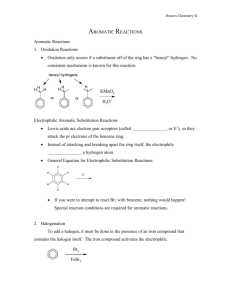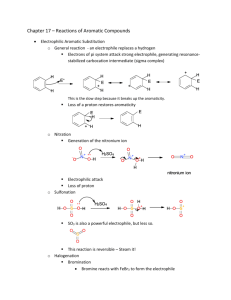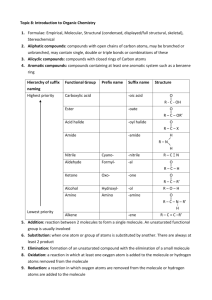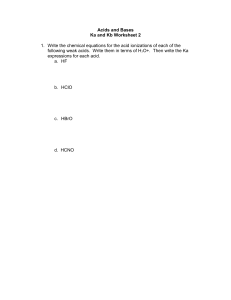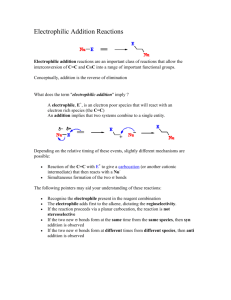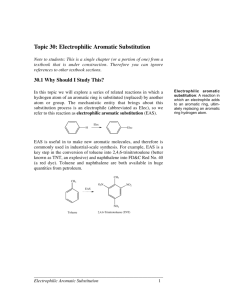Electrophilic Aromatic Substitution
advertisement
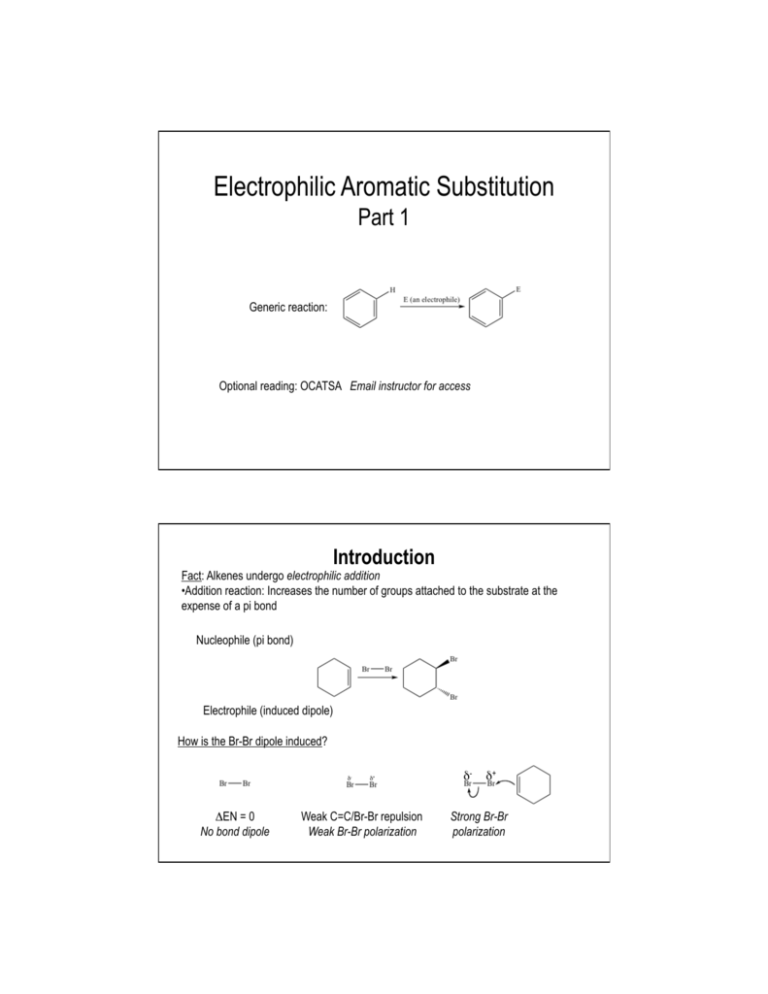
Electrophilic Aromatic Substitution Part 1 Generic reaction: Optional reading: OCATSA Email instructor for access Introduction Fact: Alkenes undergo electrophilic addition • Addition reaction: Increases the number of groups attached to the substrate at the expense of a pi bond Nucleophile (pi bond) Electrophile (induced dipole) How is the Br-Br dipole induced? δ- ΔEN = 0 No bond dipole δ+ Weak C=C/Br-Br repulsion Weak Br-Br polarization δ- δ+ Strong Br-Br polarization Addition to Benzene Pi Bonds? Question: Benzene has pi bonds...also adds Br2? No reaction Why NR? What is special about benzene? Is benzene a nucleophile? Benzene has pi electrons → Benzene is a nucleophile Is ΔG‡ too large? Benzene + Br2 gives carbocation with resonance → ΔG‡ probably ok So What It Up With Benzene? How else is benzene different from an alkene? • Aromaticity - worth 36 kcal mol-1 of stabilization • Loss of aromaticity = large increase in ΔG‡ = mechanism step too expensive How to solve this problem? • Make Br2 more electrophilic FeBr3 Electrophile = e- deficient Therefore take e- away from Br Lewis acid More electrophilic than Br2 alone Reaction and Mechanism Mechanism? Arenium ion Arenium ion resonance hybrid: Arenium Ion Fate? Arenium ion = a carbocation, so carbocation fates apply Capture a nucleophile: Be deprotonated; form pi bond: • Weak base adequate Rearrangement: Does not change overall reaction product Which carbocation fate is favored? Overall reaction Reaction Name and Kinetics Electrophilic aromatic substitution (EAS) Mechanism Kinetics: Which step is rds? • Carbocation formed • Aromaticity lost • Carbocation quenched • Aromaticity restored Reaction rate depends on: Nucleophilicity of benzene ring Arenium ion stability Strength of electrophile What If Benzene Ring Has Substituent(s)? Only one product possible Benzene + + Toluene 2-Bromotoluene Ortho-bromotoluene 3-Bromotoluene Meta-bromotoluene 4-Bromotoluene Para-bromotoluene Which Product is Major? Number of positions (probability) Ortho attack (between CH3 and H) More hindered o o m Steric hindrance to electrophilic attack m p Para attack (between H and H) Less hindered Product ratio conclusion: Arenium ion stability Product ratio conclusion: Which Product is Major? Ortho attack: Meta attack: Para attack: Product ratio conclusion: Meta attack (between H and H) Less hindered Which Product is Major? Summary • Number of positions: Ortho, meta > para • Steric effects: Meta, para > ortho • Arenium ion stability: Ortho, para > meta Which factor dominates? Ask Mother Nature... Conclusion: Arenium ion stability number of positions steric effects Directing Effects CH3 is an ortho/para director • Why? Arenium ion stability CH3 stabilizes adjacent carbocation by electron-donating inductive effect Extension: Any carbocation stabilizing group = ortho/para director Ortho/para directors Alkyl groups (-CH3, -CH2CH3, etc.) Pi bonds: Alkene, alkyne, aromatic rings Lone pairs (-X:) -OH, -OR Electron donation (resonance) -NH2, -NHR, -NR2 outweighs electron withdrawing (induction) -F, -Cl, -Br, -I } Others... In general... If it stabilizes a carbocation it is an ortho/para director. Substituent Effects: Kinetics Select the faster reaction: or • Rate-determining step: Electrophile + nucleophile → arenium ion • Electrophile: Same in both cases Nucleophilicity: • Nucleophile: CH3 is electron-donating group (EDG) H is neither EDG or EWG Arenium ion stability: • Arenium ion: CH3 is electron-donating group H is neither EDG or EWG Conclusion: Br2/FeBr3 reacts with toluene than with benzene. Activating Effects CH3 is an EAS activator Why? Relative to H... • CH3 enhances benzene ring nucleophilicity • CH3 increases arenium ion stability • CH3 is electron-donating group; stabilizes adjacent carbocation Extension: Any carbocation-stabilizing group is an activator EAS Activating Groups • Alkyl groups (-CH3, -CH2CH3, etc.) • Pi bonds: Alkene, alkyne, aromatic rings Electron donation (resonance) • Lone pairs (-X:) -OH, -OR outweighs -NH2, -NHR, -NR2 electron withdrawing (induction) } Better electron donors = more powerful activators Activating Effects: An Exception Are all ortho/para directors also activators? Yes, except F, Cl, Br, and I Why? Balance of electron-donation versus electron-withdrawal Does transition state look more like benzene ring or arenium ion? Net effect: F, Cl, Br, I are ortho/para directors, but deactivators Example: • OCH3 is ortho/para director • OCH3 is activator Ph-OCH3 EAS faster than Ph-H EAS • F is ortho/para director • F is deactivator Ph-F is slower than Ph-H EAS Substituent Effects: the Nitro Group (NO2) Predict major product: Nitro group Nitro group structure? Electrophilic Aromatic Substitution Part 2 Part 1 Summary Electrophilic aromatic substitution (EAS): Electrophilic attack on aromatic ring leads to hydrogen atom replacement Example: ortho meta Mechanism: rds Substituent effects: CH3 is an ortho/para director and activator para Substituent Effects: the Nitro Group (NO2) Predict major product: Nitro group Nitro group structure? Substituent Effects: the Nitro Group (NO2) Arenium ion stability Ortho attack: Meta attack: Para attack: Product ratio conclusion: Directing Effects NO2 is an meta director • Why? Arenium ion stability NO2 destabilizes adjacent carbocation by electron-withdrawing inductive effect Extension: Any carbocation destabilizing group = meta director Meta directors -NO2 -+NH3, -+NH2R, -+NHR2, -+NR3 -C=O (ketone, aldehyde, ester, carboxylic acid, etc.) -C≡N -CF3 -SO3H sulfonic acid Others... In general: If it destabilizes a carbocation it is a meta director. Substituent Effects: Kinetics Select the faster reaction: or • Rate-determining step: electrophile + nucleophile → arenium ion • Electrophile: same in both cases Nucleophilicity: • Nucleophile: NO2 is electron-withdrawing group (EWG) H is neither EDG or EWG < Arenium ion stability: • Arenium ion: NO2 is electron-withdrawing group H is neither EDG or EWG Conclusion: Br2/FeBr3 reacts < with nitrobenzene than with benzene. -NO2 is a deactivator Other Electrophiles: Bromination Ar-H → Ar-Br Origin of electrophile: --or-- Example: Write out the complete mechanism for yourself Other Electrophiles: Chlorination Ar-H → Ar-Cl Origin of electrophile: --or-- Example: Write out the complete mechanism for yourself What is the Electrophile? A useful pattern for remembering EAS reactions... Bromination: comes from Chlorination: comes from General EAS: comes from Other Electrophiles: Nitration Ar-H → Ar-NO2 Electrophile: +NO2 Origin of electrophile: Nitric acid --or-- Example: Write out the complete mechanism for yourself More on Directing Effects Just Who Is In Charge Here? Nitration of bromobenzene: Bromination of nitrobenzene: Generic EAS reaction: Other Electrophiles: Sulfonation Ar-H → Ar-SO3H (sulfonic acid) Electrophile: Origin of electrophile: Sulfur trioxide --or-- Example: Write out the complete mechanism for yourself Other Electrophiles: Friedel-Crafts Alkylation Ar-H → Ar-R (R = alkyl group) Electrophile: R+ (a carbocation) Origin of electrophile: Elec when R+ less stable Elec when R+ more stable • Carbocation rearrangements possible Example: Elec = +C(CH3)3 Write out the complete mechanism for yourself Other Electrophiles: Friedel-Crafts Acylation (a ketone) Electrophile: Acylium ion Origin of electrophile: Acid chloride Example: Electrophile = Write out the complete mechanism for yourself Other Electrophiles: Azo Coupling Electrophile: Diazonium cation Origin of electrophile: Mechanism? An OWLS problem Hint: NO2- + H3O+ → +NO Example: Write out the complete mechanism for yourself EAS Application Example: Synthesis of Allura Red AC • Allura Red AC (an azo dye) • Color due to extensive conjugation • Many dyes are azo compounds Ar-N=N-Ar suggests synthesis via azo coupling Strawberry soda colored with Allura Red AC Synthesis of Allura Red AC + Electrophile Azo coupling (EAS)

